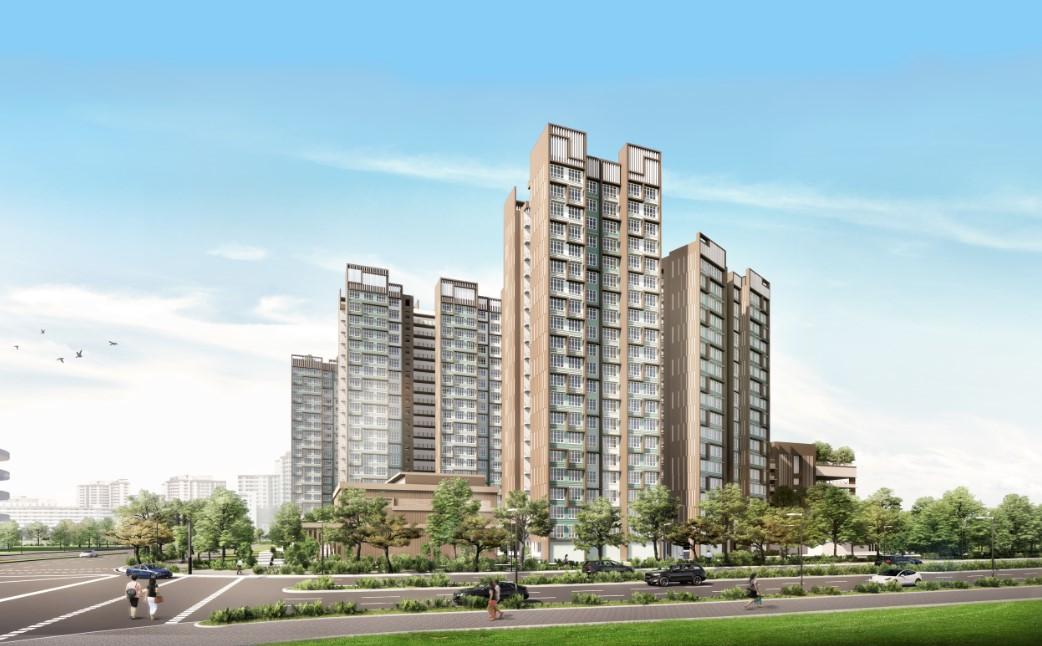Follow us on Telegram for the latest updates: https://t.me/mothershipsg
In April 2022, the Housing Development Board announced that four HDB blocks in Ang Mo Kio Avenue 3 would be the subject of the latest Selective En-Bloc Relocation Scheme (SERS) exercise.
Unexpected hostility
The news provoked a flurry of complaints. The reaction surprised many, and appears to have caught the government somewhat off guard, perhaps unaccustomed to the blowback towards what is generally considered to be a popular government policy in Singapore.
Even at its best, SERS exercises are not without quibbles. Every exercise has come with concerns and complaints about the breaking up of tight-knit communities, the cost and hassle of relocation, and the question of the ultimate relocation destination.
But these concerns are usually addressed in a methodical way. HDB employs "journey managers" to meet with homeowners one to one and explain their options, and allay concerns.
Yet in June 2022 it was clear that something about this exercise was different. Complaints about the Ang Mo Kio (AMK) exercise were stark: residents felt a lack of both consultation and options, and worse yet, looked at the prospect of extending their home leases with dread, not joy, mainly because of how much it was expected to cost them out of pocket.
On top of this were concerns that the relocation destination was decidedly further away from local amenities, including wet markets, hawker centres, and MRT stations; both AMK MRT, and the future Tavistock station.
In fact, the entire situation was taken so seriously that the Minister of National Development, Desmond Lee, introduced new policy in early July in order to be able to present disgruntled homeowners with fresh alternatives.
So, was the AMK SERS exercise a storm in a teacup?
An isolated event without lasting repercussions, or is it a sign of things to come, and can we expect the complaints encountered here to repeat themselves in the future?
A lottery where you didn’t buy a ticket, but must play
Until recently, being selected for SERS had been viewed as winning the lottery. SERS represents a bit of an anomaly in government policies, in how almost universally popular it is. The SERS website is not just positive, it is almost unabashedly cheerful. It almost congratulates you for viewing the page.
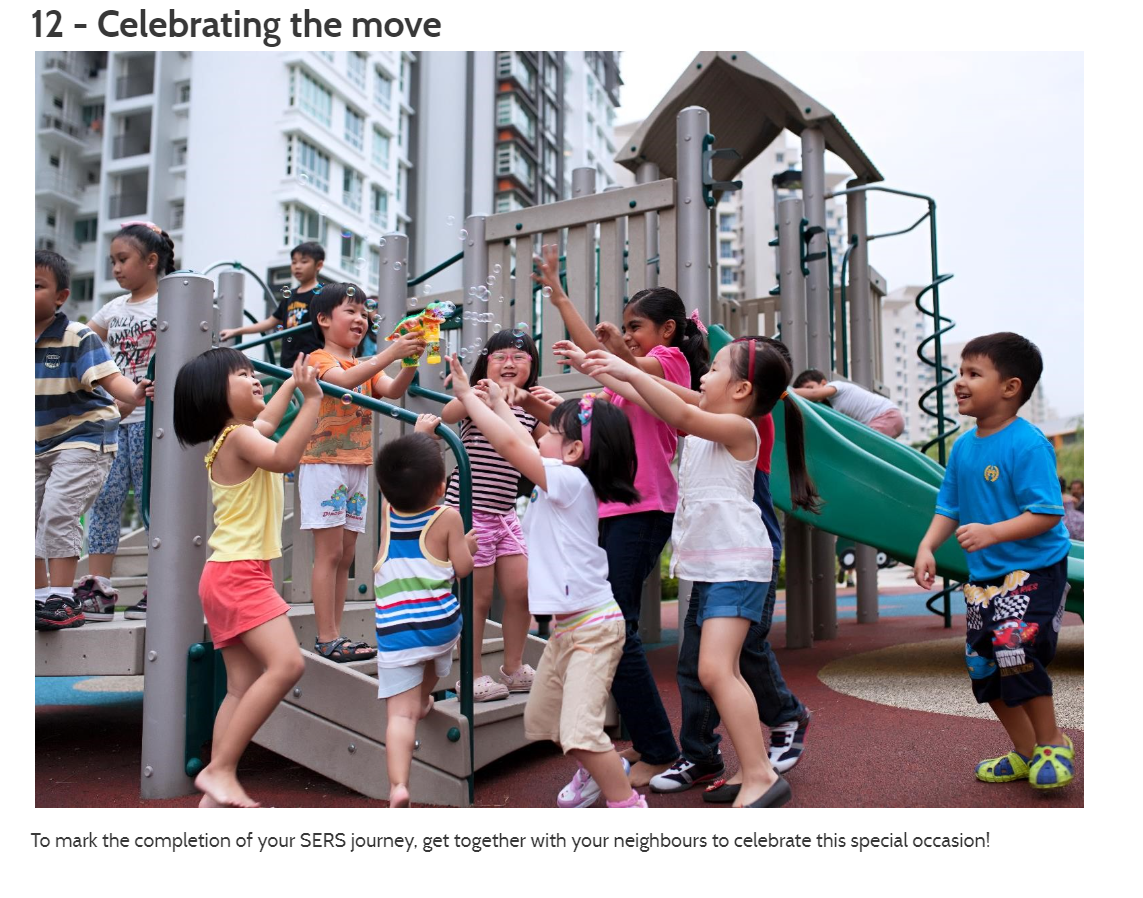 Image from HDB SERS Website
Image from HDB SERS Website
HDB’s own surveys indicate that SERS exercises have consistently shown between 85 - 90 per cent satisfaction rates. The SERS guidance page remarks that when a SERS project is announced, new and ongoing transactions of resale flats are paused for a month, to ensure that the homeowner can take maximum advantage of the windfall, although they don’t quite call it that.
With SERS selection, a homeowner gets a slew of benefits, but it is not by any means a straightforward lottery. Participation is mandatory, and winning is not always welcome.
While some of the complaints are specific to the AMK exercise, others are things that have become part of the structure of housing in Singapore, and thus will come up again in future SERS exercises. However complaints tend to revolve around three main concerns: location, demographics, and value.
Location
Further from amenities
Location is the most clearly unique aspect of the AMK exercise, both in the blocks chosen and where they will be relocated to.
Particularly, the four blocks are the closest public housing blocks to the proposed site of the Tavistock MRT station on the in-progress Cross Island Line.
While the Tavistock station itself is not slated to displace any of the surrounding buildings, a Jan. 13 CNA report said its launch tunnel will be located “a distance away from the construction site”.
Seeing how the AMK SERS blocks lie almost directly in between AMK and Tavistock station, it might be possible that the site was picked to facilitate the tunnelling works, and that HDB was taking advantage of that to redevelop the site.
But the location of the new line also causes some problems for the relocation. Residents who might have been initially excited at the prospect of having a new station close to their home from 2030, find themselves being moved to a new address that is not only further from the new Tavistock station, but also notably further from the AMK station as well.
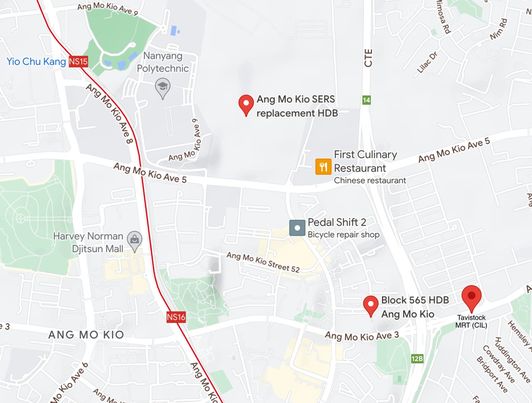 Image from Google Maps
Image from Google Maps
Contrast this with the newly announced Marsiling Acquisition Exercise. While this is not, strictly speaking, a SERS exercise, it is in all but name. The only difference is that HDB is not the ultimate acquirer of the land, but the Immigration and Checkpoints Authority (ICA).
Owners of the Marsiling flats are being offered units that are significantly closer to the Marsiling MRT station and its amenities.
Is the AMK SERS project a sign of things to come?
But there are also some key ways in which the AMK SERS project is a sign of things to come in future SERS projects.
To begin with, there’s a possibility of other blocks in the same AMK neighbourhood that could potentially be SERS-ed too. The four blocks in AMK are not especially exceptional in terms of their age (built in or around 1980), location (AMK), or density (mostly three and four-room flats in 12-storey blocks).
Could the recent AMK SERS be the start of the neighbourhood (or, a chunk of it) being acquired for redevelopment in the years to come?
Demographics
Flats getting older before they get SERS-ed
Outside of AMK, this recent SERS project also has potential implications for future ones.
Three of the four AMK blocks getting SERS-ed were first occupied in 1980, meaning that they are over 42 years old.
By the time the residents move out in 2028, the flats would be 48 years old, nearly the halfway point of their lease.
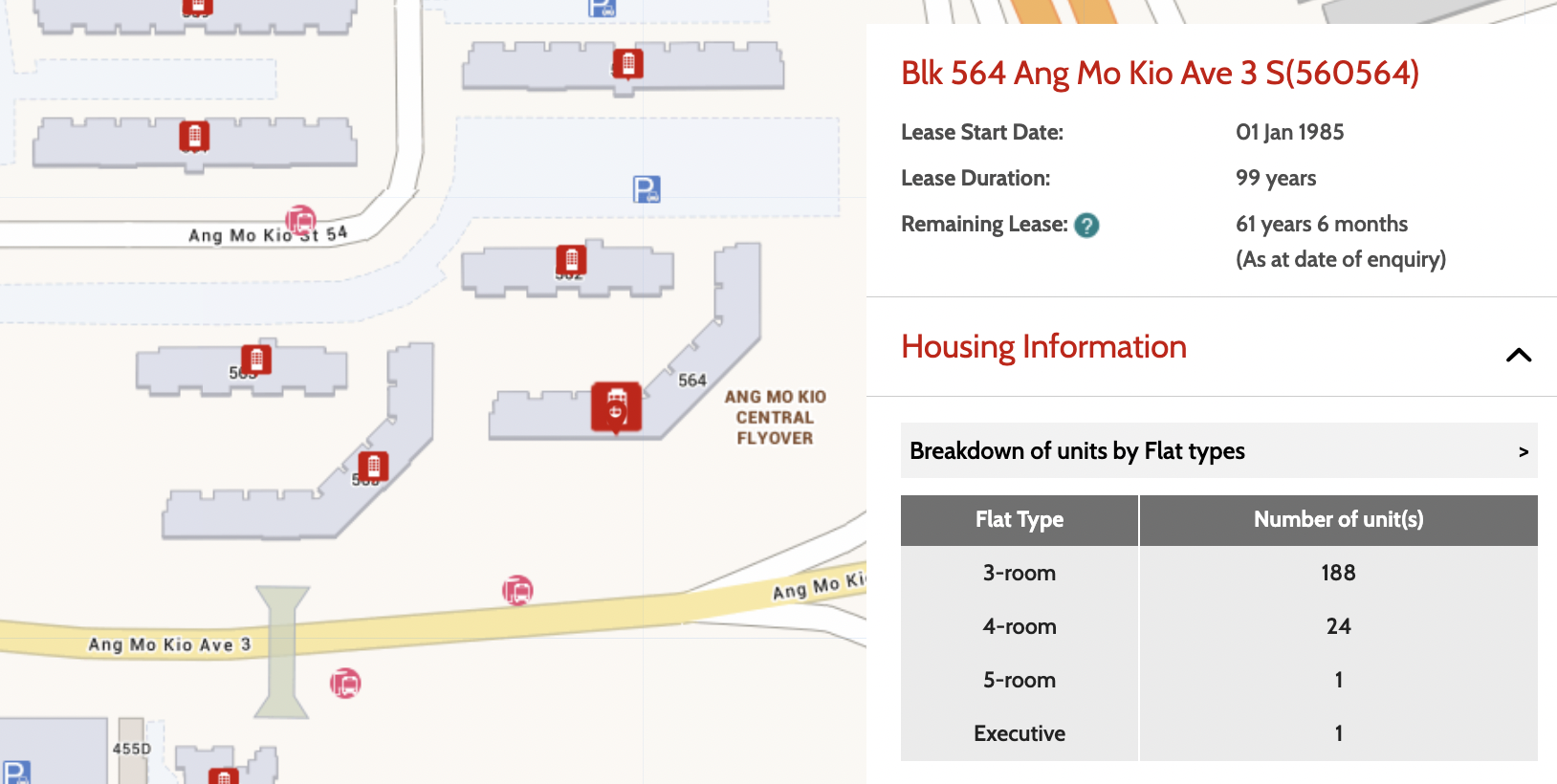 Screenshot via HDB website.
Screenshot via HDB website.
One of the blocks, Block 564, had their leases start in 1985, a few years later than the other three blocks. It was included in the SERS exercise, as the new development on the site presumably requires the entire plot of land.
This points to a larger trend — that SERS projects over time will involve older and older blocks, and with that, older and older residents.
This much was acknowledged by national development minister Desmond Lee, who noted that previous SERS flats were “generally younger” at the point when SERS was announced.
The owners of older flats getting acquired under SERS would thus be receiving smaller compensation amounts.
“Looking ahead, the flats involved in future SERS exercises are also likely to be older, with shorter remaining terms,” said Lee.
People getting older before they are SERS-ed
The follow on consequence of older flats and older estates is older people. The average age of HDB residents has been creeping upwards.
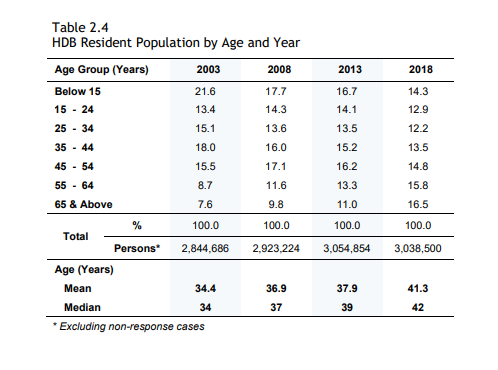 Image from 2018 HDB Household Survey
Image from 2018 HDB Household Survey
According to HDB’s 2018 Household Survey, the median age of the HDB resident population is now 42, and 47.1 per cent of residents are above the age of 45. 16.5 per cent of residents are older than 65, 5.5 per cent higher than 2013.
This means that even more residents will not have the income to afford SERS top-ups, or will have great difficulty getting bank loans.
And if the flats in future SERS exercises are to be older, it stands to reason that the age profile will be older too, likely more so than the numbers we’ve already presented.
Value
SERS flat owners less likely to afford 1-to-1 swaps
Here’s the impact of flats getting older, and compensation amounts getting smaller: The lucky (or unlucky) winners of the SERS “lottery” will be less and less likely to be able to afford a 1-to-1 swap when it comes to purchasing a replacement flat.
Some in the AMK SERS project were vexed that a same-size flat would require a significant top-up amount — in the excess of S$160,000 for some.
This is likely to be the case for many homeowners in future SERS projects, and not just the ones at AMK.
New option to buy 50-year lease
The government’s solution to this issue? Offering a 50-year lease option. Basically, if you can’t afford a brand new 99-year lease replacement flat, you can buy half a replacement flat.
Or rather, a replacement flat with a half-term lease of 50 years.
While somewhat revolutionary in the SERS context, it has predecessor schemes, such as the Lease Buyback Scheme (LBS).
And it is set to be a lot more common. It applies retroactively to the owners of AMK SERS flats, the Marsiling SERS-equivalent flats, and future SERS projects.
In fact, offering HDB flats with shorter lease was something already being studied, “for older home-owners involved in SERS exercises”, according to Lee, provided they are over 45, so that the flats can be their “home for life” till age 95 at least.
Lee also said that exceptions are possible, for younger owners:
“For those who do not meet the home-for-life criterion and face extenuating circumstances, we will consider availing them of the 50-year lease option on a case-by-case basis, if they are open to this option.”
Will the 50-year lease option be popular? Does it matter?
One of the issues surrounding the new 50-year lease option is that owners have to pay more than half the purchase price for half the lease period.
While this makes sense on paper (due to the time value of money), it can be hard for some to accept, especially in the case of AMK, where certain specific factors (such as location) make the SERS replacement far less attractive than in previous projects.
Depending on the price of the new flats and the exact compensation offered, an AMK SERS resident who opts for a similar-sized flat on a 50-year lease may feel that the only benefit from the entire exercise is a slight extension of a few years’ lease in the new flat.
This benefit would come at the cost of sacrificing things like the relatively more favourable location, the sentimental cost of leaving their old neighbourhood and housing unit, and renovation costs.
It is therefore possible that the 50-year option does not become a popular one.
“Social media generation”
Another unique aspect of AMK SERS that is likely to play out in future projects is social media amplification.
What’s being amplified? The voices of unhappy residents, and their various grouses.
The Straits Times (ST) reported that in 2011, the residents of eight blocks in East Coast and Rochor Centre were similarly disaffected over the location of the replacement flats in Chai Chee and Kallang respectively.
Same same, but different, in the case of AMK SERS, where an increasingly digitally-literate and connected community came together to sign a public petition over their gripes.
Videos of emotionally-charged interactions between AMK residents and national development minister Lee were circulated on platforms like Facebook, literally giving a voice to residents’ complaints.
This trend of increasingly public confrontation will likely continue for future SERS projects involving unhappy residents.
Looking ahead
Ultimately, AMK SERS tells us that there will be both program-specific issues, and also site-specific ones that will shape people’s reaction to each redevelopment exercise.
HDB repeated in the Ang Mo Kio SERS announcement that “only about five per cent of all HDB flats are suitable for redevelopment under SERS, and most of these projects with high redevelopment potential have already been selected for the scheme.”
This means that while the complaints and issues surrounding the Ang Mo Kio exercise may continue to grow and deepen, the opportunity for them to be expressed during SERS exercises will decrease as time goes on.
41,000 households have been included in SERS projects, out of nearly 1.09 million HDB households, roughly 3.75 per cent. Based on the 5 per cent number, this means that there might only be 13,000 households left that can be included in SERS projects.
These points are likely to be relevant to the Voluntary Early Redevelopment Scheme (VERS) — the less-selective, voluntary version of SERS, with less generous compensation — when it starts.
With not much known about VERS so far, it’s difficult to guess how these voluntary redevelopment exercises will play out.
What is known however is that VERS will only be made available to HDB blocks that are older than 70 years in age, inclusion in VERS will be, like SERS, initiated by the government, and that the terms offered to VERS recipients will not be as generous as those offered under SERS.
However, VERS recipients will be able to vote on the package offered, and will thus be able to decide if they take up the offer or live out the remainder of their lease.
One thing’s certain though: VERS will be more complicated than SERS, with owners' consent being part of the equation. It remains to be seen if the government can take the opportunity to resolve discussion on HDB redevelopment once and for all.
Top image via HDB Ang Mo Kio Drive website
If you like what you read, follow us on Facebook, Instagram, Twitter and Telegram to get the latest updates.
